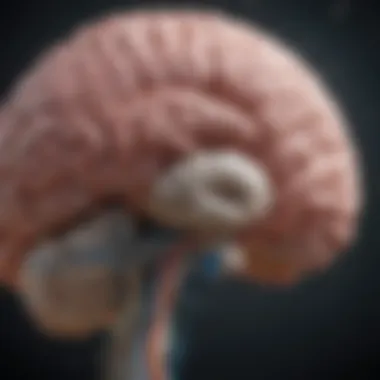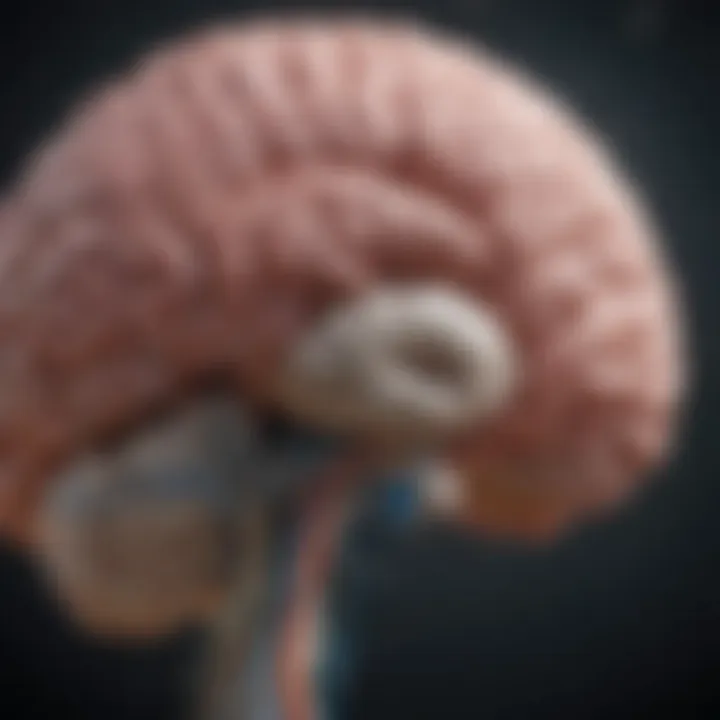Cognitive Neuroscience: Principles and Advancements


Intro
Cognitive neuroscience exists at the nexus of psychology and neuroscience, probing the intricate workings of the human mind. This discipline not only enhances our understanding of cognitive processes but also serves as a critical tool for addressing various cognitive disorders. With a rich history grounded in interdisciplinary methods, this article aims to provide comprehensive insights into the principles and advancements that define cognitive neuroscience today.
By exploring key methodologies and notable findings, we will understand how cognitive neuroscience informs both theoretical frameworks and practical applications. This exploration also highlights the continuous evolution of the field, as new technologies emerge, particularly in neuroimaging. Ultimately, this overview aims to illuminate the implications of research in cognitive neuroscience for students, educators, researchers, and professionals alike.
Key Findings
Summary of the Main Results
Recent research in cognitive neuroscience has yielded several significant findings that advance our understanding of human cognition. One key discovery is the localization of specific cognitive functions within distinct brain regions. For instance, studies using functional Magnetic Resonance Imaging (fMRI) have identified areas such as the prefrontal cortex as crucial for decision making and social cognition. Similarly, the role of the hippocampus in memory formation and retrieval consistently surfaces in research.
Another noteworthy result pertains to the brain's plasticity. Neuroplasticity, the brain's ability to reorganize itself by forming new neural connections, has profound implications. It suggests that cognitive training and therapeutic interventions can enhance cognitive functions, even in individuals with impairments.
Significance of Findings within the Scientific Community
These findings have reshaped the field, prompting further investigation into the underlying mechanisms of cognitive processing. The localization of cognitive functions has challenged traditional views on consciousness and cognition, suggesting a more modular approach to understanding the mind. Additionally, the emphasis on neuroplasticity has opened pathways for new therapies targeting conditions like stroke, traumatic brain injury, and psychiatric disorders.
Researchers are now more equipped to develop interventions that could enhance cognitive performance, offering hope to many.
Implications of the Research
Applications of Findings in Real-World Scenarios
The advancements in cognitive neuroscience have far-reaching applications across various domains. In education, insights into how the brain learns can inform teaching methodologies, making learning more effective. Cognitive training programs, designed from neuroscience findings, can help improve memory and attention in both children and adults.
Moreover, in clinical contexts, understanding the neurobiological underpinnings of cognitive disorders paves the way for targeted therapeutic approaches. For example, cognitive behavioral therapy can be enhanced through neuroscientific principles, creating more effective treatment plans for conditions such as anxiety and depression.
Potential Impact on Future Research Directions
Future research in cognitive neuroscience is likely to focus on several promising areas. One emerging trend is the integration of artificial intelligence with neuroimaging technologies. This combination can help decode brain activity patterns, revealing new insights into cognitive processes. Additionally, as research continues to uncover the nuances of brain function, interdisciplinary collaborations will become increasingly important.
The ongoing dialogue between neuroscience, artificial intelligence, and psychology holds the potential to revolutionize our understanding of cognition and enhance therapeutic strategies.
In summary, cognitive neuroscience not only enriches our theoretical understanding of the human mind but also holds substantial practical implications for advancements in education and mental health treatment.
By synthesizing these insights, we can appreciate the depth and significance of cognitive neuroscience as an evolving field, continually pushing the boundaries of what we know about human cognition.
Preface to Cognitive Neuroscience
Cognitive neuroscience is a dynamic field that unites the principles of neuroscience with the processes of cognition. Its significance lies in understanding how the brain influences behavior and cognitive functions. This article emphasizes the relevance of cognitive neuroscience by exploring its foundational concepts, methodologies, advancements, and the implications for cognitive disorders.
The study of cognitive neuroscience promotes insights into understanding complex mental processes like memory, language, and decision-making. It bridges gaps between abstract cognitive theories and empirical neuroscientific findings. As our understanding of the brain progresses, recognizing the intricate relationship between cognitive functions and neural mechanisms becomes crucial for addressing various cognitive disorders.
Ultimately, this field offers immense potential for improving educational strategies, clinical interventions, and enhancing our overall understanding of human behavior and thought. It serves as a foundation for research that attracts students, educators, professionals, and researchers eager to explore this multi-faceted discipline.
Definition and Scope
Cognitive neuroscience can be defined as the scientific study of the neural mechanisms underlying cognition. This encompasses processes such as perception, attention, memory, language, and decision making. By examining how the brain supports these cognitive functions, researchers can gain insights into the connections between neuronal activity and mental experiences.
The scope of cognitive neuroscience is vast, integrating disciplines such as psychology, biology, and computer science to understand how the brain operates. Various methodologies, including neuroimaging techniques and behavioral assessments, contribute to this interdisciplinary field. Identifying these connections enables the exploration of complex questions regarding how thoughts and behaviors are generated in the brain and how they relate to each other.
Historical Context
Cognitive neuroscience has evolved from a series of foundational theories and methodologies that emerged over decades. Its roots trace back to the study of neuroanatomy in the 19th century, where pioneers like Paul Broca investigated the links between specific brain areas and cognitive functions. The development of localization theory laid the groundwork for understanding that certain regions of the brain are responsible for distinct cognitive tasks.
In the latter half of the 20th century, advancements in technology fostered further exploration of the brain's inner workings. The advent of neuroimaging techniques, such as functional Magnetic Resonance Imaging (fMRI) and Positron Emission Tomography (PET), revolutionized the field. Researchers could now observe brain activity in real time as subjects engaged in cognitive tasks.
The history of cognitive neuroscience reflects a continuous interplay between theoretical advancements and technological progress. Over the years, it has broadened its focus to include cognitive disorders, educational applications, and the implications on artificial intelligence, underscoring its relevance in contemporary scientific discourse.
"Cognitive neuroscience not only enhances our understanding of the brain but also paves the way for better clinical practices and therapeutic strategies that address cognitive impairments."
Understanding this interplay enriches our appreciation for the complexities of the human mind as informed by neuroscientific principles.
Foundational Concepts
Foundational concepts in cognitive neuroscience set the stage for understanding the intricate relationship between mental processes and the brain's mechanisms. These concepts are crucial as they outline the basic principles and terms that govern both fields. Understanding cognition and neuroscience separately creates a framework that helps in comprehending their interdependence. Moreover, these concepts inform various methodologies and approaches used throughout cognitive neuroscience research, ensuring that findings are robust and reliable.
Cognition: An Overview
Cognition refers to a wide range of mental processes, including perception, memory, reasoning, and decision-making. It encompasses how people acquire, process, store, and retrieve information. In essence, cognition is pivotal in forming the basis of our thoughts and behaviors. Different cognitive functions interact in complex ways, often requiring multiple processes to work in tandem. For example, memory is essential for problem-solving, as it allows individuals to draw on past experiences when making decisions. Understanding cognition provides insights into how individuals navigate their environment and engage with the world around them.
Cognition can be dissected into several key components:


- Attention: The ability to focus selectively on specific stimuli while ignoring others.
- Memory: The processes involved in encoding, storing, and recalling information.
- Perception: How sensory information is interpreted to understand the surroundings.
A deeper understanding of cognition benefits various fields, from psychology to artificial intelligence. It connects directly to ensuring that advancements in technology and therapeutic approaches are grounded in human cognitive principles.
Neuroscience Basics
Neuroscience explores the structure and function of the nervous system, particularly the brain. By examining neurons, synapses, and neural networks, it provides a detailed look at how biological processes correlate with mental activities. Neural mechanisms underpinning cognitive functions are essential for understanding how mental processes emerge from physical processes. For instance, learning occurs through synaptic changes, where connections improve with repeated stimulation.
Neuroscience covers several disciplines, including:
- Molecular Neuroscience: Investigates the molecular level of the nervous system.
- Systems Neuroscience: Looks at how different brain systems interact to produce behavior.
- Cognitive Neuroscience: Focuses on the neural substrates of cognitive processes.
Awareness of these basic principles aids researchers in designing experiments, interpreting findings, and applying results to real-world scenarios. It helps draw connections between observable behavior and underlying biological mechanisms.
Interconnection Between Cognition and Neuroscience
The interconnection between cognition and neuroscience is fundamental to enhancing our understanding of human behavior and mental health. As cognitive functions manifest through neural activities, exploring this relationship offers profound insights. For instance, functional magnetic resonance imaging (fMRI) has opened new doors to observe brain areas activated during cognitive tasks, thus integrating behavioral data with neurological evidence.
Several specific areas of interest include:
- Cognitive Disorders: Studying brain anomalies to understand conditions like ADHD or dyslexia informs treatments and interventions.
- Learning Processes: Aligning cognitive theories of learning with neural plasticity provides a more effective approach to education.
- Decision-Making: Investigating how brain activity shapes choices allows for better understanding of judgments and behaviors.
As cognitive neuroscience progresses, it increasingly reveals how changing neural mechanisms can lead to variations in cognition and vice versa. The synthesis of both fields illustrates a dynamic interaction, deepening the collective understanding of the human mind.
Methodologies in Cognitive Neuroscience
The methodologies used in cognitive neuroscience are fundamental for understanding how cognitive processes relate to brain function. These approaches not only facilitate the mapping of brain activity but also aid in the elucidation of complex cognitive mechanisms. Researchers rely on various techniques that allow for both qualitative and quantitative data collection, enabling deeper insights into how cognitive functions are executed in the brain. The integration of these methodologies helps to bridge gaps between theoretical constructs and empirical research, making them essential tools in the field.
Neuroimaging Techniques
Neuroimaging techniques are pivotal in cognitive neuroscience. They provide a window into the living brain, highlighting the neural substrates of cognitive functions.
Functional Magnetic Resonance Imaging (fMRI)
Functional Magnetic Resonance Imaging, or fMRI, is a non-invasive imaging technique favored for its high spatial resolution. It measures brain activity by detecting changes in blood flow, which correlate with neuronal activity. This ability to visualize brain regions that activate during specific tasks makes fMRI a valuable tool for studying cognition. One key characteristic of fMRI is its capacity to create detailed 3D images of brain activity while subjects perform cognitive tasks.
The unique feature of fMRI is its emphasis on hemodynamic responses rather than electrical activities. This means it provides insights into what regions are active, although it can be less precise in timing. Advantages of fMRI include its safety and its detailed-resolution images. However, it requires subjects to remain still, which can be a limitation in studies involving certain populations, such as children or clinical populations.
Electroencephalography (EEG)
Electroencephalography, known as EEG, tracks electrical activity in the brain through electrodes placed on the scalp. It is particularly beneficial for its temporal resolution, capturing brainwave activity in real-time. This technique is instrumental in studying processes such as attention, perception, and memory, which unfold rapidly over milliseconds.
EEG’s key strength lies in its ability to show time-sensitive changes in brain activity, making it valuable for experiments where timing is crucial. Its unique feature is the capacity to detect shifts in brain wave patterns with high precision. However, it provides limited spatial resolution. One downside is the reliance on a layout of electrodes that may not capture all brain regions effectively.
Positron Emission Tomography (PET)
Positron Emission Tomography, or PET, is an imaging technique that assesses metabolic processes in the brain. By injecting a radiolabeled tracer, PET enables researchers to observe how certain areas of the brain consume glucose, informing on overall brain activity. Its key characteristic is the ability to provide information on both functional and anatomical aspects of brain regions.
The unique feature is that PET can illustrate both localized neural activity and broader metabolic changes, which makes it less common than fMRI for psychological studies. One advantage of PET is its ability to measure neurotransmitter activity, giving insights into biochemistry. However, its disadvantages include lower temporal resolution compared to EEG and the necessity for radiolabeled tracers, which may impose risks in certain populations.
Behavioral Assessments
Behavioral assessments are essential tools that help researchers examine cognitive functions in real-world contexts. They offer insights into cognitive processes by examining how individuals respond to various stimuli and tasks.
Cognitive Tasks
Cognitive tasks are structured activities designed to assess specific aspects of cognition related to perception, memory, and problem-solving skills. These tasks are crucial to examining how cognitive functions manifest in behavior. Their structured nature allows for replicable outcomes, lending reliability to experimental findings.
One key characteristic is that cognitive tasks can be tailored to evaluate specific functions, such as attention span or working memory. They are beneficial because they help measure performance under controlled conditions. However, their limitation lies in the artificiality of task settings, which may not reflect the nuances of real-world cognitive function.
Psychometric Testing
Psychometric testing encompasses a range of standardized assessments that evaluate cognitive abilities, personality traits, and mental health conditions. These will provide quantitative data which can be compared across individuals or populations. Psychometric tests are beneficial because they enable large-scale comparisons and can provide nuanced diagnostic information.
A unique feature of psychometric testing is that it can be used to identify patterns across different cognitive functions. One advantage is its scalability, making it useful in both clinical and research settings. However, drawbacks may include cultural bias in tests and the potential for misinterpretation of results if taken out of context.
Experimental Design in Cognitive Research
Experimental design plays a crucial role in cognitive research by structuring how studies are approached and how data is gathered. A well-thought-out experimental design ensures that findings contribute meaningfully to the understanding of cognitive processes. It encompasses the selection of appropriate methods, participant selection, and the overall approach to data analysis. This meticulous planning allows for replication of studies, which is vital for the validation of findings across different research contexts.
In cognitive neuroscience, integrating methodologies, such as combining neuroimaging with behavioral assessments, can provide richer data and possibly lead to groundbreaking discoveries. By carefully orchestrating these elements, researchers can explore the complexities of the human mind more effectively.
Key Findings in Cognitive Neuroscience


Cognitive neuroscience has unveiled remarkable insights into how our mental processes align with brain function. The findings in this domain have broad implications for various fields, including psychology, education, and clinical practice. Understanding memory, attention, language, and decision-making through the lens of neuroscience allows for a more nuanced appreciation of human behavior and cognitive disorders.
These key discoveries provide a foundation for future research and therapeutic interventions. Recognizing how different cognitive functions are localized or distributed within the brain can lead to improved educational techniques and better-targeted treatments for cognitive impairments. Researchers uncover dynamic interactions between cognition and neural mechanisms, which deserve careful examination and consideration.
"The synergy between cognitive processes and neural substrates redefines our understanding of the mind and brain, pushing boundaries of traditional cognition approaches."
Memory and Learning
Memory is one of the most studied areas in cognitive neuroscience. Research indicates that different types of memory—such as short-term and long-term—are governed by distinct neural circuits. The hippocampus, for instance, plays a pivotal role in forming new memories, while the prefrontal cortex is essential for working memory.
Understanding how learning occurs involves not only the encoding of information but also its consolidation and retrieval. Neuroplasticity, the brain’s ability to reorganize itself, is fundamental here. It emphasizes the capacity for growth and adaptation across the lifespan, which has significant ramifications for education and rehabilitation strategies.
Attention and Perception
Attention is a critical cognitive function that influences how we process sensory information. Identifying the neurological underpinnings of attention has led to insights into disorders such as ADHD. Studies suggest that key areas like the anterior cingulate cortex and parietal cortex are involved in modulating attentional processes.
Perception is closely linked to attention; how we interpret stimuli stems from both bottom-up sensory information and top-down cognitive structures. Understanding these connections can refine diagnostic practices and support the development of interventions that aid sensory processing in individuals with perceptual difficulties.
Language Processing
The study of language processing reveals that distinct areas in the brain are specialized for different aspects of language, such as comprehension and production. Broca's area, for example, is vital for speech production, whereas Wernicke's area is associated with language comprehension. Recent advancements in neuroimaging have enhanced our understanding of these language networks and their dynamic interactions during communication.
Exploring how brain damage affects language capabilities has direct implications for therapeutic strategies. For instance, techniques in speech rehabilitation often leverage this understanding to create effective recovery programs for individuals with aphasia or other language impairments.
Decision Making and Executive Functioning
Decision-making processes and executive functioning are integral components of cognitive neuroscience. Research has shown that these functions are not merely about logical reasoning but involve emotional inputs and social contexts as well. The prefrontal cortex is essential in orchestrating executive functions such as planning, problem-solving, and controlling impulses.
Disruptions in these areas can lead to significant challenges in daily life and influence conditions like autism and addiction. Understanding the underlying neural mechanisms behind decision-making helps in developing interventions that can mitigate cognitive deficits and enhance self-control strategies for individuals facing these challenges.
Cognitive Neuroscience and Disorders
Cognitive neuroscience plays a crucial role in understanding various cognitive disorders. It examines how brain function correlates with the psychological aspects of these disorders. Through this lens, we can appreciate the complexity and multifaceted nature of cognitive impairments affecting individuals. Understanding cognitive disorders helps identify how neurological disruptions manifest in behaviors and thinking.
This section will delve into two key aspects: a thorough comprehension of cognitive disorders and the scientific approaches being adopted to treat them. Knowledge of these elements enables practitioners and researchers to design targeted interventions that can greatly benefit those struggling with such disorders.
Understanding Cognitive Disorders
Cognitive disorders encompass a wide range of conditions that impair cognitive functioning. These include, but are not limited to, dementia, Alzheimer's disease, and attention deficit hyperactivity disorder (ADHD). Understanding these disorders requires a multi-disciplinary approach. Cognitive neuroscience helps elucidate the neural mechanisms underpinning these conditions.
Examining brain scans, neural pathways, and chemical imbalances, researchers can map out how these issues arise. For instance, Alzheimer's disease often shows a decline in specific brain regions crucial for memory. Understanding such patterns assists in crafting more efficacious treatment plans.
Moreover, cognitive disorders can significantly affect daily life, impacting social interactions and job performance. Addressing these challenges must consider psychological, social, and neuroscientific perspectives to provide holistic care.
Neuroscience Approaches to Treatment
The treatment of cognitive disorders spans various methodologies. Neuroscience approaches to treatment include pharmacological interventions, psychoeducation, and neurofeedback. Each contributes uniquely to improving outcomes for individuals affected by these disorders.
Pharmacological Interventions
Pharmacological interventions involve the use of medication to manage symptoms of cognitive disorders. These medications aim to correct chemical imbalances in the brain that contribute to cognitive decline. Key characteristics of these interventions often include their ability to improve focus, memory, and overall cognitive function temporarily, making them a popular choice in treatment plans.
A unique feature of pharmacological interventions is the wide spectrum of drugs available, from stimulants like methylphenidate used for ADHD to cholinesterase inhibitors for Alzheimer's disease. While they can be quite effective, these interventions also come with advantages and disadvantages. For instance, while medications can improve symptoms, they may also cause side effects that need monitoring.
Psychoeducation
Psychoeducation focuses on providing individuals and families with knowledge about cognitive disorders. This method empowers patients to understand their conditions. The key characteristic of psychoeducation is its emphasis on fostering awareness and promoting coping strategies. It is a beneficial choice because it enhances communication between patients and healthcare providers.
Psychoeducation's unique feature lies in its collaborative approach. By informing patients about their conditions, it can lead to improved adherence to treatment plans. However, there are challenges, such as varying degrees of understanding among patients, which can affect outcomes.
Neurofeedback
Neurofeedback is an emerging technique that uses real-time displays of brain activity to help individuals alter their brain function. Key characteristics of neurofeedback include its non-invasive nature and potential for training brain patterns associated with improved cognitive functioning.
It is considered a beneficial method due to its ability to empower patients in their treatment. By learning to regulate their brain activity, individuals can experience enhanced focus and emotional control. The unique feature of neurofeedback is its adaptability to various disorders. Nevertheless, it may require substantial time and commitment from patients, which can be a disadvantage for those with cognitive impairments.
Understanding and treating cognitive disorders through neuroscience has profound implications for improving quality of life. By exploring these approaches, we can tailor interventions that resonate with patients' needs, ultimately enhancing their cognitive resilience.
Interdisciplinary Nature of Cognitive Neuroscience
Cognitive neuroscience stands as a testament to the convergence of diverse scientific fields, showcasing how an interdisciplinary approach can lead to richer insights into the human mind. This realm sits at the interface of psychology, neuroscience, computer science, and philosophy. Each discipline contributes unique perspectives and methodologies that enhance understanding of cognition and its underlying neural mechanisms. The significance of this interdisciplinary nature cannot be overstated, as it fosters collaboration among experts with varied expertise, leading to innovative approaches and discoveries.
Integration with Psychology


Psychology plays a central role in cognitive neuroscience. Theories from psychology provide frameworks for understanding cognitive processes, such as memory, perception, and decision-making. By integrating psychological principles, cognitive neuroscience can explore how neural circuits underlie these mental activities. For example, investigating how different types of memory are represented in the brain often relies on established psychological theories.
Psychological assessments, such as cognitive tasks, are crucial for measuring and quantifying cognitive functions. Neuroimaging techniques like functional Magnetic Resonance Imaging (fMRI) can visualize brain activity while individuals perform these tasks. The insights gained from combining psychological assessments with neuroimaging can yield profound implications for both fields, such as understanding cognitive impairments in various disorders.
Collaboration with Computer Science
The collaboration between cognitive neuroscience and computer science is another vital component that drives innovation in the field. Advances in computational modeling allow researchers to simulate cognitive functions, providing valuable insights into neural dynamics. This intersection is particularly evident in the development of artificial intelligence and machine learning algorithms that attempt to mimic human cognitive processes.
Brain-Computer Interfaces (BCIs) exemplify this collaboration. BCIs utilize principles from neuroscience to develop technology that translates neural activity into commands for computers. Such advancements have significant implications for rehabilitation and assistive technology, transforming the way individuals with disabilities interact with their environment. Be it through assistive applications or advances in understanding complex brain functions, the melding of these two disciplines shows promise for future developments.
Impact of Philosophy on Cognitive Neuroscience
Philosophy contributes a critical lens through which cognitive neuroscience can examine fundamental questions about consciousness, perception, and the mind-body problem. This discipline encourages critical thinking about the implications of neuroscientific findings and how they relate to human experience. Philosophers raise questions about the nature of the self, free will, and the essence of consciousness, driving cognitive neuroscientists to consider not just what the brain does, but what it means for who we are.
Research addressing these philosophical questions can influence ethical considerations in cognitive neuroscience, particularly regarding the treatment of cognitive disorders and enhancement technologies. Further, philosophical inquiry stimulates discussions around the interpretation of data collected through neuroimaging techniques, emphasizing the need to contextualize scientific findings within broader existential frameworks.
"The integration of diverse fields reveals the complexity of cognition and the interconnectedness of various systems in understanding the mind."
In summary, the interdisciplinary nature of cognitive neuroscience enriches the field substantially. By weaving together insights from psychology, technology from computer science, and philosophical inquiry, cognitive neuroscience presents a multifaceted approach to understanding cognition. Ultimately, this collaboration has the potential to yield groundbreaking advancements that improve our grasp of the human mind and its disorders.
Emerging Trends in Cognitive Neuroscience
Emerging trends in cognitive neuroscience are reshaping our understanding of the brain and its functions. These developments highlight not only innovations but also the evolving methodologies that enhance research and applications. The integration of complex technologies and interdisciplinary approaches defines this contemporary landscape. Recognizing these trends is essential for anyone involved in cognitive neuroscience, from students to seasoned researchers.
Artificial Intelligence and Cognitive Modeling
Artificial intelligence (AI) is playing a significant role in cognitive neuroscience. Cognitive modeling using AI helps simulate human thought processes. This can lead to deeper insights into how cognitive functions operate and how they can be affected by various factors. For instance, machine learning algorithms can decode brain activity patterns and predict behavioral outcomes with impressive accuracy.
Benefits of AI in cognitive modeling include:
- Increased Analysis Speed: Rapid data processing allows researchers to analyze larger volumes of data that were previously unmanageable.
- Improved Predictive Capabilities: AI enhances the ability to predict how cognitive functions might change under different conditions or treatments.
- Personalized Approaches: Using AI, researchers can develop customized therapies for cognitive disorders based on individual data.
However, there are considerations regarding ethical implications and the need for rigorous validation of AI models to ensure reliability.
Brain-Computer Interfaces
Brain-computer interfaces (BCIs) are another exciting area in cognitive neuroscience. These systems allow direct communication between the brain and external devices. BCIs can aid individuals with disabilities by providing them with new ways to interact with technology, enhancing their quality of life.
Applications of BCIs are diverse, including:
- Restoration of Lost Functions: BCIs can help in restoring movement for paralyzed patients.
- Neurofeedback Training: This technique is used for mental health treatments, allowing individuals to gain control over specific cognitive states.
- Enhancing Cognitive Performance: Researchers explore how BCIs can improve memory and learning.
The development of BCIs poses challenges as well. Issues around privacy, security, and long-term effects on brain function need thorough investigation.
Global Research Initiatives
Global research initiatives in cognitive neuroscience are fostering collaboration across borders and disciplines. These initiatives aim to tackle complex brain-related questions and share findings rapidly among the scientific community. An emphasis on open science enables widespread access to data and research findings, driving innovation.
Key aspects of global research initiatives include:
- Collaboration: Multi-institutional projects encourage diverse perspectives and approaches to common problems.
- Standardization: Efforts to standardize research methodologies support consistency in findings across studies.
- Data Sharing: Platforms that allow sharing of data among researchers enhance transparency and facilitate faster advancements.
In summary, the impact of these emerging trends on cognitive neuroscience is profound. Artificial intelligence, brain-computer interfaces, and global initiatives are paving the way for breakthroughs that were once thought impossible. As these trends develop, they contribute to a deeper understanding of cognitive functions and the mechanisms that underlie them.
Future Directions in Cognitive Neuroscience
The future of cognitive neuroscience is an ever-evolving landscape filled with both challenges and promising opportunities. As researchers and professionals delve deeper into the human mind, several key elements are emerging that will shape the field in the coming years. This section not only underscores the significance of exploring these directions but also highlights the integration of new technologies and interdisciplinary approaches. Understanding these future directions is crucial, as they can significantly impact how we comprehend cognitive processes and their underlying neural mechanisms.
Challenges and Opportunities
Cognitive neuroscience faces a variety of challenges that can inhibit progress. One primary challenge is the complexity of the human brain itself. Despite advancements in technology, our understanding of brain function remains incomplete. The challenge is further compounded by individual variability in cognition and neuroscience, which adds an additional layer of complexity to research and therapeutic interventions.
Another significant challenge is data management and interpretation. With the growing use of neuroimaging techniques, massive amounts of data need to be analyzed, requiring sophisticated algorithms and computational power. This can lead to potential biases and issues regarding data validity.
Despite these challenges, there are considerable opportunities ahead for cognitive neuroscience:
- Interdisciplinary Collaborations: Collaboration with fields such as artificial intelligence and computational biology can unveil richer insights into cognitive processes.
- Enhanced Therapeutic Interventions: The opportunity to develop targeted, personalized interventions based on cognitive assessments can lead to better outcomes for patients.
- Global Research Initiatives: Participation in international research programs can enhance communication and synergy between researchers, creating a more robust understanding of cognitive neuroscience.
The interplay of challenges and opportunities in cognitive neuroscience lays the groundwork for breakthroughs that can redefine how we understand cognition.
Innovations on the Horizon
As we look toward the future, several innovations are poised to have a transformative impact on cognitive neuroscience. One of these innovations is the advancement of brain-computer interfaces (BCIs). BCIs aim to establish direct communication paths between the brain and external devices, potentially revolutionizing rehabilitation strategies for individuals with cognitive impairments.
The integration of artificial intelligence into cognitive neuroscience is another critical trend. AI algorithms can analyze complex datasets to identify patterns and correlations in cognitive functions that would be nearly impossible for humans to discern on their own. This could lead to significant advancements in understanding neural mechanisms underlying various cognitive tasks.
Moreover, the trend toward open science will facilitate broader access to research findings. By sharing data openly, researchers can leverage collective intelligence, accelerating the pace of discovery. New platforms and resources, such as online databases, will allow for improved collaboration among researchers worldwide.
Such innovations not only enhance our understanding of cognitive functions but also possess profound implications for educational practices, therapeutic methods, and the potential for cognitive enhancement.







